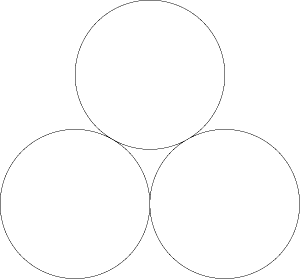Stack them up!
 Two smooth cylindrical bars weighing
each lie next to each other in contact. A similar third bar is placed over the two bars as shown in the figure.
Two smooth cylindrical bars weighing
each lie next to each other in contact. A similar third bar is placed over the two bars as shown in the figure.
To keep the bottom two cylinders in contact equal and opposite horizontal forces are applied at the centers of both the bottom cylinders.
If the friction is neglected, what is the minimum horizontal force on one of the cylinders required to keep them in contact?
The answer is 10.
This section requires Javascript.
You are seeing this because something didn't load right. We suggest you, (a) try
refreshing the page, (b) enabling javascript if it is disabled on your browser and,
finally, (c)
loading the
non-javascript version of this page
. We're sorry about the hassle.
This is just a shortened solution.
Basically, draw the free body diagram of the centre of mass's of each cylinder. Let the normal reaction from one of the bottom cylinders on the top one be N . Thus, the horizontal components of the two normals cancel each other, and the vertical components cancel the weight of 2 0 3 . By symmetry, we can say that each normal must balance 1 0 3 .
Thus, N sin θ = 1 0 3
Since the centre of masses form an equilateral triangle, θ = 6 0
Therefore, N = 2 0
The action for N is also 2 0 newtons. Thus, the horizontal component, which must be countered by the applied force, is 2 0 cos 6 0 = 1 0 newtons.